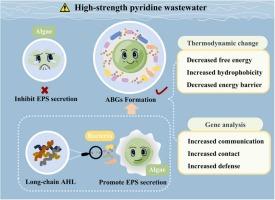IF 12.2
1区 环境科学与生态学
Q1 ENGINEERING, ENVIRONMENTAL
引用次数: 0
摘要
藻类-细菌颗粒(ABGs)系统具有高沉降性、高效氧气传输和低能耗等优点,是一种很有前景的有机废水处理技术。然而,藻类分泌的胞外高分子物质(EPS)在 ABGs 的自组装过程中起着关键作用,而浓缩的有机废水会抑制 EPS 的分泌。本研究提出了一种通过应用高强度吡啶诱导细菌 N-酰基-高丝氨酸内酯(AHL)变异来开发 ABG 的新策略。结果表明,在 550 mg L-1 的高浓度吡啶作用下,细菌长链 AHL 浓度显著增加,从而诱导藻类分泌胞外芳香蛋白,促进 ABGs 的构建。ABGs 系统对吡啶的去除率超过 99%,沉降性达到 82%。此外,ABGs 细胞外芳香蛋白中的β-片状结构和α-螺旋结构比例增加,而无规线圈结构比例减少。蛋白质结构的这种变化降低了表面自由能和能量障碍,进而增强了表面疏水性,促进了细胞粘附。此外,基于元转录组学分析,提出了 ABGs 中 AHL 调节藻类与细菌之间生理和行为反应的机制。这项研究为开发用于工业废水处理的高效、可持续 ABGs 系统提供了一种经济可行的方法。本文章由计算机程序翻译,如有差异,请以英文原文为准。

Self-assembly of algal-bacterial granules induced by bacterial N-acyl-homoserine lactone variation in response to high-strength pyridine
Algal-bacterial granules (ABGs) system represents a promising technology for organic wastewater treatment due to its high settleability, efficient oxygen transfer, and low-energy consumption. However, the secretion of extracellular polymeric substances (EPS) in algae, which played a key role in self-assembly of ABGs, would be inhibited by concentrated organic wastewater. This study proposed a novel strategy for developing ABGs by inducing bacterial N-acyl-homoserine lactone (AHL) variation through high-strength pyridine application. Results showed that bacterial long-chain AHL concentrations significantly increased in response to high-strength pyridine at 550 mg L-1, inducing the secretion of algal extracellular aromatic proteins and facilitating ABGs construction. The ABGs system achieved over 99% pyridine removal efficiency and 82% settleability. Moreover, the proportions of β-sheet and α-helix structures in the extracellular aromatic proteins of ABGs increased, while the random coil structures decreased. This shift in protein structure lowered the surface free energy and energy barriers, which in turn enhanced the surface hydrophobicity and promoted cell adhesion. Furthermore, based on metatranscriptomic analysis, the mechanism for AHL-regulated physiological and behavioral responses between algae and bacteria in ABGs was proposed. This study provides an economically feasible approach to develop efficient and sustainable ABGs systems for industrial wastewater treatment.
求助全文
通过发布文献求助,成功后即可免费获取论文全文。
去求助
来源期刊

Journal of Hazardous Materials
工程技术-工程:环境
CiteScore
25.40
自引率
5.90%
发文量
3059
审稿时长
58 days
期刊介绍:
The Journal of Hazardous Materials serves as a global platform for promoting cutting-edge research in the field of Environmental Science and Engineering. Our publication features a wide range of articles, including full-length research papers, review articles, and perspectives, with the aim of enhancing our understanding of the dangers and risks associated with various materials concerning public health and the environment. It is important to note that the term "environmental contaminants" refers specifically to substances that pose hazardous effects through contamination, while excluding those that do not have such impacts on the environment or human health. Moreover, we emphasize the distinction between wastes and hazardous materials in order to provide further clarity on the scope of the journal. We have a keen interest in exploring specific compounds and microbial agents that have adverse effects on the environment.
 求助内容:
求助内容: 应助结果提醒方式:
应助结果提醒方式:


